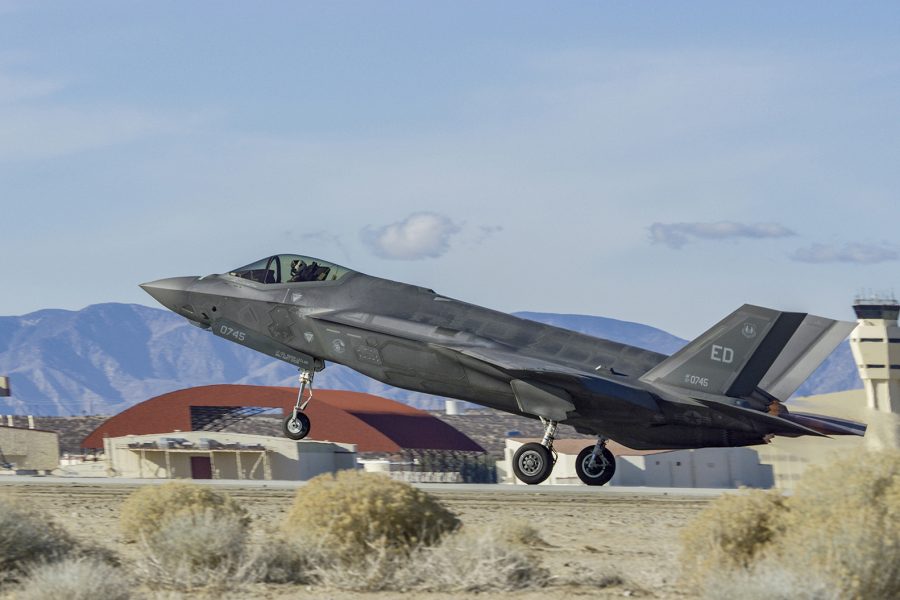The continuing hold on F-35 deliveries, pending completion of the Tech Refresh 3 upgrade testing, is having an operational and financial impact on the Air Force, Secretary Frank Kendall told reporters March 7.
“It’s hurting already,” Kendall said during a briefing after the McAleese defense conference in Washington, D.C.
“We really need the TR-3 hardware and the Block 4 set of upgrades … to stay competitive,” Kendall said. “And we’re going to need them in quantity, so getting on with that is really important to us.”
The delay in acceptance “affects cost,” he added.
The government stopped accepting new F-35s from Lockheed Martin last fall, since new aircraft were being manufactured with the TR-3 hardware and software but the upgrade is still in testing. Both the Joint Program Office and Lockheed have officially forecast that testing will be completed—and the flow of new jets can resume—by mid-2024, although Lockheed CEO Jim Taiclet told reporters in January that “late summer may be a more likely scenario” for TR-3 acceptance.
“Where we expected to replace airplanes, we now are not. So, we’ve got to carry the existing aircraft, generally speaking, for longer than we had planned,” Kendall said. That results in additional, unplanned costs for maintenance, spare parts, training, and more, although he noted that “I don’t know that I’m seeing a lot of financial impact of the delay yet.”
However, “the operational capability impact is significant,” he said. Of the 70 or so aircraft that are completed but not delivered, sources said more than 30 are F-35A models destined for U.S. Air Force units. They will replace aircraft in units that now fly the A-10 and the F-16, and the delay has disrupted training and assignments for both pilots and ground crews that will transition from those aircraft to the F-35.
The F-35 delivery hold affects not only the U.S. services but international users as well, and the program partners have discussed accepting jets with less than the full TR-3 capability—a so-called “truncated” configuration—in order to get deliveries moving again.
The F-35 Joint Program Office said in January that this plan “to accept aircraft ahead of full validation” of TR-3 capabilities is “focused on delivering capable aircraft to the warfighters,” but offered no timetable regarding when this might happen.
Asked if the Air Force would accept jets with less than the full TR-3 capability, Kendall said, “We had some debates about that.”
However, Kendall had to recuse himself from those discussions because of his previous business relationship with Northrop Grumman, the maker of the AN/APG-85 radar that will equip the Block 4 version of the F-35.
“I deferred to Gen. [Charles Q. Brown, Jr., chairman of the Joint Chiefs of Staff] on that and he made the call. It’s a judgment call,” Kendall said. “In general, I want to hold industry responsible for delivering what they promised. And so my bias, if there is one, is to not accept products” that are not as promised, he said.
“But there’s an operational argument to be made,” he added, given that the preferred outcome is “a better capability” than the services now have. The TR-3 is a step up from the TR-2 versions which were the last to be delivered.
Lockheed executive vice president for aeronautics Greg Ulmer, told Air & Space Forces Magazine in February that testing of TR-3 at Edwards Air Force Base, Calif., and Patuxent River Naval Air Station, Md., is showing “improved performance with the TR-3,” with improved software stability and “significant” new weapons capability.
He said production TR-3 software had at that time been flying at the company’s Fort Worth, Texas, plant and racked up “20 production flights.” Although he could not say with certainty when TR-3 testing will be complete, he said his belief was that it would happen in summer 2024.
As to a release with less than the full TR-3 capability, he said Lockheed is working with the JPO “to define what the deliverable key release will be, but I’m not going to get into specifics. … That’s for the JPO to decide and we’ll align to that requirement.”
